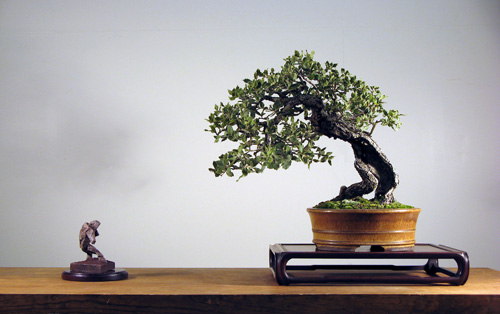
This is the second and final installment of our Michael Hagedorn interview.
Do you collect wild trees? Any advice if you do?
I do collect. And I would definitely advise studying the techniques of taking wild trees with a very experienced collector who has a high success rate. Studying this seriously is better than learning by mistake and experiment—enough have done that already!
The tree pictured above is Sonoran scrub live oak (Quercus turbinella). Michael says of this tree: I collected this oak from a mountain range in eastern Arizona in 1999, at around 5,000 ft. It was growing much like old pines or junipers along rocky breaks, in a ‘captive root’ situation. There were fine roots in a pocket of soil on bedrock. I cut the anchor root, lifted the tree, and it went into a small box. The oak from the start was very vigorous, and one or two years later was in a bonsai pot. The photo is from 2008, prior to its trip to the National Bonsai Show. Accent is a small sculpture that I made in college. The container is from my past life as a potter. To see more of Michael’s trees, visit Crataegus Bonsai.
What are your favorite trees to work with? Have you done much with local varieties?
Mostly working with native trees now, at least in the conifer group. In Japan I used to get out of bed in the morning for Japanese maple and stewartia, and I still work a lot with those. I like juniper quite a bit too, for its abstract qualities. Otherwise, as a rough sketch, I have Engelmann spruce, mountain hemlock, and various native pines and junipers in my backyard.
Do you still make your own pots?
Have not made any since returning from Japan. Still, I often see a tree in my backyard and think, ‘What if I had a pot like this…’ so it might come back in a small way, someday.
Do you have plans for any more books?
Yes, I’m working on something now, not stories and essays this time but about bonsai. Still too early to say what it is exactly, but I’m writing.
You have a chapter entitled “Through a Wash of Zen” that I enjoyed very much. My assumption is that to write this, you must practice Zen. Am I correct in this assumption?
I did meditate some in Japan, but am not a Zen practitioner in any consistent way. It did prove to be a useful tool in that stressful environment. Japanese culture and Zen seem well suited to one another…
Do you miss Japanese food?
Some things. I really miss the bento box we got every noontime. It came on a tiny truck that would be outside the studio about 10 every morning. I still remember the oscillation of that truck, and running out to meet it. The bento was perfect: a good portion of rice, some fish or meat, and a cornucopia of vegetables. It was just the right size and impossible to overeat.
The Japanese actually did many things intelligently this way, for example, there was no super-sizing of portions in the fast food restaurants (which are popular.) I was not a Japanophile, loving everything about Japan, but many things they did admirably. Food was one of them. And yet some of the crazier stories from my apprenticeship seemed to be about food. If raw horse is not your cup of tea—well, it was not mine either—but if you’re curious about that culinary adventure, it is detailed in Post-Dated.
I really wanna buy this amazing book …but I live in Brazil and it`s dificult …but I will buy it one day for sure …
Thank`s Michael for all .
Roberto Gerpe.
My email is : bobgerpe@yahoo.com
Thanks for getting in touch Roberto,
We do ship books to Brazil on a regular basis. It appears that there is a thriving bonsai community there.